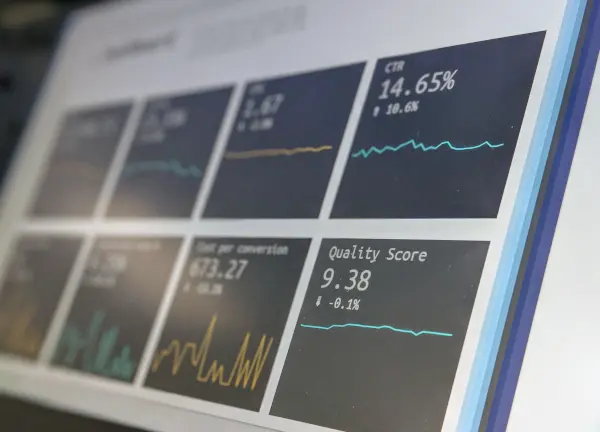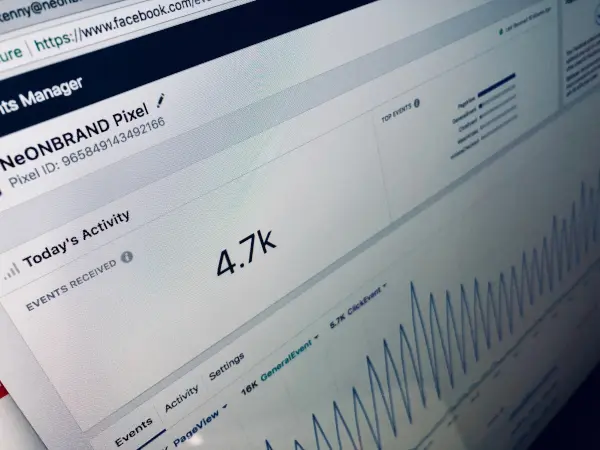As an online retailer, understanding and interpreting data is to be expected. But, what our team of web optimization experts has found, is that a lot of ecommerce businesses don’t really know what metrics are worth paying attention to, don’t know how to make decisions based on the data they have access to, or realize that the ability to understand user behavior is the secret ingredient to success. In an effort to help those who may be lost, we are taking a moment to review the subject of analytics and data tracking for the ecommerce business owner or proprietor. These tools empower businesses like yours to make smart, data-driven decisions, optimize websites, improve search engine visibility, and engage customers. In this article, we’ll dive deep into the world of analytics and data tracking for ecommerce websites, uncovering how you can use them to drive growth and achieve even more success!
- Setting Up Web Analytics: Getting Started
- Understanding Key Performance Indicators (KPIs): Metrics That Matter
- Utilizing Ecommerce Analytics: Unleash the Insights
- Advanced Analytics Techniques: Take It to the Next Level
- Leveraging SEO Analytics: Conquer the Search Game
- Making Data-Driven Decisions: It’s Decision Time!
- Conclusion: Embrace the Data, Thrive in Ecommerce
Setting Up Web Analytics: Getting Started
Alright, let’s kick things off by setting up web analytics for your ecommerce website. It’s like laying the groundwork for all the data goodness you’re about to unleash. Here’s what you need to do:
First things first, let’s talk about web analytics and why it’s so darn important for ecommerce. Web analytics is all about collecting, measuring, and analyzing data related to how people use your website. It gives you precious insights into your visitors’ behaviors, actions, and interactions. Simply put, these tools serve as a window into all areas of your online presence.
Now, how do you choose the right web analytics tool? Well, a popular one that gets the job done is Google Analytics. It offers a bunch of fantastic features like audience analysis, conversion tracking, and goal setting. Being that Google is the most popular and widely used Search Engine, it only stands to reason that they would have access to some of the best real-time information about your site and it’s traffic, right? But hey, don’t feel limited – there are other tools out there too. Tools such as Ahrefs, SEMrush, and MOZ all have the ability to provide you good data if setup correctly. Just pick the one, or more, that align with your business goals and your technical abilities.
Once you’ve chosen your tool(s), it’s time to implement some tracking magic. Grab the tracking code provided by your chosen analytics tool and make sure it’s added to every single page of your ecommerce website. That way, you’ll capture visitor data accurately and efficiently. You will sometimes hear this referred to as a pixel, so don’t let that throw you off. Every tools has different ways of integrating this short code into the site; some are added via alterations to the website’s source code, others may be installed on the server or hosting side of the website, and some are plugins that are installed into the CMS directly.
To track customer behavior like a pro, you’ll want to configure some goals, funnels, and events. After all, how do we know if we are going in the right direction if we don’t know which direction to head in? When setting up web analytics for your ecommerce website, here are some example goals you can consider:
- Increase conversion rate: Track the percentage of visitors who make a purchase on your website and aim to improve that rate over time.
- Improve average order value: Set a goal to increase the average amount customers spend on each order, which can boost your overall revenue.
- Reduce bounce rate: Aim to decrease the percentage of visitors who leave your website after viewing only one page by improving site navigation, content relevance, and user experience.
- Enhance user engagement: Set a goal to increase the average time visitors spend on your website or the number of pages they view per session, indicating higher engagement levels.
- Decrease cart abandonment rate: Track the percentage of visitors who add items to their cart but do not complete the purchase. Aim to reduce this rate by optimizing the checkout process, addressing common pain points, and offering incentives.
- Increase website traffic: Set a goal to improve the number of visitors to your website through various channels such as organic search, paid advertising, social media, or referrals.
- Monitor customer retention: Track the customer lifetime value and set a goal to increase repeat purchases or encourage long-term loyalty among your customer base.
- Improve ROI on marketing campaigns: Set specific goals to measure the return on investment for your marketing efforts, such as tracking conversions from different campaigns or channels.
Remember, these are just a few examples, and your goals may vary depending on your business objectives and industry. It’s important to set goals that align with your overall business strategy and continuously monitor and adjust them as needed.
Funnels, on the other hand, help you analyze the steps visitors take on their way to conversion. And events? They let you track specific interactions, like clicks on buttons or downloads. Sweet, right?

Understanding Key Performance Indicators (KPIs): Metrics That Matter
Now that your analytics setup is rockin’, it’s time to get cozy with some Key Performance Indicators (KPIs). These are the metrics that tell you whether your ecommerce business is crushing it or needs a little boost. Here are some examples of KPIs for different areas of your ecommerce website:
1. Revenue-focused KPIs:
- Conversion rate: The percentage of visitors who make a purchase. It indicates the effectiveness of your website in converting visitors into customers.
- Average order value: The average amount spent by customers per order. Increasing this metric can lead to higher revenue.
- Customer lifetime value: The total value a customer brings to your business over their lifetime. It helps measure customer loyalty and guides marketing efforts.
2. User-focused KPIs:
- Bounce rate: The percentage of visitors who leave your website after viewing only one page. A high bounce rate may indicate issues with user experience or content relevance.
- Time on site: The average amount of time visitors spend on your website. Longer durations often indicate higher engagement and interest.
- Page views per session: The average number of pages viewed by a visitor during a single session. It reflects user engagement and the stickiness of your website.
3. Marketing-focused KPIs:
- Traffic sources: The channels through which visitors arrive at your website, such as organic search, paid advertising, or social media. Analyzing traffic sources helps allocate marketing resources effectively.
- Click-through rates: The percentage of users who click on a specific link or advertisement. It measures the effectiveness of your call-to-actions and marketing campaigns.
- Cost per acquisition: The average cost of acquiring a customer. It helps evaluate the profitability of your marketing efforts.
Keep in mind that these are just some of the many, many KPIs that exist. We are just dipping our toe into the formidable ocean of data that exists online. Understanding how users use the internet and how their behavior can be tracked and displayed are just the first steps towards being able to make better business decisions.
Now, let’s get a little more focused on ecommerce-specific analytics!

Utilizing Ecommerce Analytics: Unleash the Insights
Alright, now that you’re tracking like a pro and keeping an eye on those KPIs, it’s time to dive into the juicy insights ecommerce analytics can provide. Let’s unleash those valuable insights that drive your online business to new heights. Buckle up, because we’re about to discover some game-changing strategies!
1. Analyzing customer behavior: Where the Magic Happens
Alright, listen up! Your analytics hold the key to understanding how your customers behave on your website. It’s like having a backstage pass to the secret lives of your visitors. Take a close look at their user flows, which show you the paths they take through your website. Do they follow the intended journey, or are they getting lost along the way? Identify those popular entry and exit points, and optimize them like a pro.
Oh, and don’t forget to keep an eye on navigation paths. They’ll reveal the exact sequence of pages your visitors follow, giving you insights into what interests them the most. If you spot any bottlenecks or roadblocks, it’s time to clear the path and make their experience smoother than a ride on a magic carpet.
2. Evaluating product performance: The Stars of the Show
Let’s give a round of applause to your products – the true stars of your ecommerce website! With analytics, you can uncover their performance secrets and figure out what makes them shine brighter than the rest. Identify your top-selling products and understand why customers are flocking to them. Is it the irresistible descriptions, the eye-catching visuals, or something else entirely? Use this knowledge to replicate that success across your entire product lineup.
But wait, there’s more! Analytics also allow you to assess revenue by product category. This gem of information helps you identify which categories are raining down the cash and which ones need a little boost. It’s like having your very own crystal ball, guiding you towards the most profitable avenues.
3. Assessing marketing effectiveness: The ROI Magic Trick
Are your marketing efforts hitting the bullseye, or are they missing the mark? Analytics comes to the rescue once again! It’s time to put your advertising campaigns under the microscope and measure their return on investment (ROI). Identify which campaigns are bringing in the big bucks and which ones are draining your budget without delivering results. With this knowledge, you can allocate your resources wisely and focus on the strategies that truly work like magic.
But that’s not all! Analytics can also reveal the secret sources behind your website’s success. Which channels are driving the most traffic? Is it the mighty power of organic search, the captivating allure of social media, or something else entirely? By analyzing referral traffic, you’ll unlock the mysteries of where your visitors are coming from. This allows you to double down on those high-performing channels and work your marketing magic accordingly.
4. Monitoring cart abandonment: The Battle against Lost Sales
Ah, cart abandonment – the sworn enemy of every ecommerce store. Fear not, for analytics is here to lend a helping hand in this epic battle! With its mighty insights, you can identify the friction points that cause visitors to abandon their carts and leave your virtual aisles empty-handed. Is your checkout process too lengthy or confusing? Are unexpected costs popping up like a villainous surprise twist? Discover these pain points and eliminate them like a hero on a mission.
Optimizing the checkout process is your secret weapon to winning the battle against cart abandonment. Streamline it, make it intuitive, and remove any obstacles standing in the way of a smooth transaction. Your customers will thank you, and your conversion rates will soar higher than a superhero in flight.
So there you have it – a glimpse into the world of utilizing ecommerce analytics and unleashing game-changing insights. With these strategies in your arsenal, you’re equipped to make data-driven decisions that will supercharge your online business. Embrace the power of analytics and watch the magic unfold before your eyes!

Advanced Analytics Techniques: Take It to the Next Level
Alright, you’re rocking the basics of analytics. Now it’s time to level up and unleash some advanced techniques to supercharge your ecommerce insights. These are the opportunities that are often over-looked by your competitors.
1. A/B testing: Experiment like a Mad Scientist
Ever wondered what would happen if you changed the color of your “Buy Now” button or tweaked your product descriptions? Well, wonder no more! A/B testing allows you to conduct experiments on your website and measure the impact of different variations. It’s like being a mad scientist in a lab, but instead of potions, you’re playing with website elements.
Here’s how it works: Create two versions of a webpage, with one element changed in the second version. Split your traffic between the two variations and see which one performs better. It could be a different headline, layout, or even a call-to-action. Let the data guide you to the winning variation and optimize your website for maximum impact. It’s all about finding what resonates with your audience and boosting those conversions like a boss!
2. Cohort analysis: Unveil the Journey Over Time
Your customers’ journey doesn’t end with a single purchase – it’s a continuous adventure. Cohort analysis allows you to understand how user behavior changes over time and track their interactions with your brand. It’s like a time machine that reveals the secrets of customer retention and loyalty.
Segment your customers into groups based on when they made their first purchase or joined your website. Then, analyze their behavior and engagement patterns within each cohort. Are certain cohorts more likely to make repeat purchases? Do they exhibit different browsing habits or product preferences? With cohort analysis, you’ll gain insights into how your customers evolve over time, allowing you to tailor your marketing strategies and deliver personalized experiences that keep them coming back for more.
3. Customer segmentation: Paint a Picture of Your Audience
Every customer is unique, and customer segmentation allows you to understand and target their specific needs and preferences. It’s like creating personas that bring your audience to life. By segmenting your customers based on demographics, behavior, or purchasing patterns, you can tailor your marketing efforts to resonate with each segment.
Imagine this: You have a segment of young, tech-savvy customers who prefer trendy products, and another segment of older, value-conscious shoppers who appreciate quality and reliability. By understanding their distinct characteristics, you can customize your messaging, promotions, and product recommendations to appeal to each group. It’s like having a conversation with your customers on their terms, building stronger connections and driving more meaningful engagement.
4. Heatmaps and session recordings: See Through Your Customers’ Eyes
Ever wish you could see exactly how your customers interact with your website? Heatmaps and session recordings make that wish come true! Heatmaps provide a visual representation of where visitors click, scroll, or hover on your website. It’s like having x-ray vision to see what elements capture their attention and what areas go unnoticed.
Session recordings, on the other hand, allow you to watch actual recordings of user sessions on your website. It’s like being a fly on the wall, observing how visitors navigate, what catches their eye, and where they encounter challenges. These insights help you identify usability issues, optimize your website’s layout, and create a seamless user experience that keeps visitors hooked.
So, there you have it – advanced analytics techniques that will take your ecommerce insights to new heights. Experiment like a mad scientist, travel through time with cohort analysis, understand your customers through segmentation, and see through their eyes with heatmaps and session recordings. It’s time to tap into the power of advanced analytics and unlock a world of data-driven growth for your ecommerce business.

Leveraging SEO Analytics: Conquer the Search Game
Ah, SEO – the magical world of search engine optimization. Analytics plays a vital role in mastering the art of SEO for your ecommerce website. Let’s unlock the secrets to improving your website’s visibility, attracting organic traffic, and climbing those search engine rankings. It’s time to unleash your SEO superpowers!
1. Keyword research: The Quest for Relevance
Imagine you’re a detective on a mission to uncover the most relevant keywords for your business. Keyword research is your trusty magnifying glass, guiding you to the phrases and terms your target audience is searching for. It’s like stepping into their minds and understanding their needs.
Start by brainstorming words and phrases related to your products or services. Then, use keyword research tools like Google Keyword Planner or SEMrush to identify search volumes, competition, and related keywords. Find that sweet spot where relevance and search volume intersect, and incorporate those keywords naturally throughout your website.
Remember, it’s not just about stuffing keywords everywhere. It’s about weaving them into valuable content that satisfies your visitors’ search intent. With the right keywords in your arsenal, you’ll be a step ahead in the search game.
2. Tracking organic traffic: Follow the Path to Success
Your website’s organic traffic is like a trail of breadcrumbs leading to success. SEO analytics helps you follow that trail and understand where your organic traffic is coming from, which pages are performing well, and how users are interacting with your content.
Dive into your analytics and explore metrics like organic search traffic, top landing pages, and bounce rates. Are there specific pages or topics that consistently attract visitors? Identify those golden nuggets and optimize them further. Are there pages with high bounce rates? Time to investigate and enhance their relevance and user experience.
By tracking organic traffic, you’ll unveil the secrets of what’s working and what needs improvement. It’s like having a compass that guides you towards greater visibility and engagement.
3. Monitoring backlinks: Building Bridges to Authority
Backlinks are the bridges that connect your website to authority and credibility. They are like votes of confidence from other websites, signaling to search engines that your content is valuable and worth ranking higher.
Use SEO analytics tools to monitor your backlinks and gain insights into their quality, quantity, and the referring domains. Are you getting backlinks from reputable websites in your industry? Fantastic! Keep nurturing those relationships and seeking opportunities for more. Are there toxic or spammy backlinks? It’s time to disavow and clean up your backlink profile.
Remember, it’s not just about the number of backlinks; it’s about their relevance and authority. Focus on building high-quality backlinks that truly strengthen your website’s reputation.
4. Optimizing for mobile: Embrace the Small Screen
In today’s mobile-driven world, optimizing your website for mobile users is no longer optional—it’s a necessity. SEO analytics can provide insights into mobile user behavior, allowing you to fine-tune the mobile experience and ensure a seamless journey for your visitors.
Explore metrics like mobile traffic, bounce rates, and time on site specifically for mobile users. Are there pages that perform differently on mobile compared to desktop? Identify any usability issues, such as slow loading times or difficult navigation, and optimize them for the small screen.
Remember, mobile optimization isn’t just about responsive design; it’s about creating a delightful and intuitive experience that keeps mobile users engaged and satisfied.
So, there you have it – the power of SEO analytics to conquer the search game. Uncover relevant keywords, track organic traffic, monitor backlinks, and optimize for mobile. With these SEO superpowers, you’ll rise in the search engine rankings and attract a steady stream of organic traffic to your website. It’s time to let your SEO prowess shine and leave your competitors in the dust.

Making Data-Driven Decisions: It’s Decision Time!
Alright, you’ve gathered all this juicy data, but what’s the point if you don’t use it to drive your decision-making? It’s time to unleash the power of data and make smart moves. Here’s how:
1. Analyzing trends and patterns: Unveiling Opportunities
Data analytics unveils trends and patterns that hide beneath the surface. It’s like having a crystal ball that reveals opportunities for growth and success. Dive into your analytics and identify recurring patterns in customer behavior, purchasing trends, or website performance.
Are there certain times of the year when sales spike? Are there specific products that experience a surge in popularity? By understanding these trends, you can align your marketing efforts, stock up on in-demand products, and tailor promotions to maximize your results. It’s like riding the wave of opportunity and taking your business to new heights.
2. Conducting competitor analysis: The Quest for a Competitive Edge
In the competitive world of ecommerce, keeping an eye on your competitors is crucial. With analytics, you can conduct competitor analysis and gain a competitive edge. It’s like being a detective, uncovering the strategies and tactics that set your rivals apart.
Analyze your competitors’ website performance, marketing campaigns, and customer engagement metrics. Are they excelling in certain areas? What can you learn from their successes or failures? By understanding the competitive landscape, you can fine-tune your own strategies, differentiate yourself, and position your business as the go-to choice for customers. It’s like having a secret weapon that helps you stay one step ahead.
3. Implementing iterative improvements: Small Steps, Big Impact
Data-driven decisions are not about making one grandiose change—it’s about implementing iterative improvements that compound over time. Think of it as a series of small steps that lead to a big impact.
Analyze your data regularly, identify areas for improvement, and make incremental changes. Test different website elements, tweak your marketing strategies, or optimize your checkout process. Then, monitor the impact of those changes through analytics. Are your conversion rates improving? Are customers spending more time on your site? By making data-driven iterations, you can refine your business and continuously enhance the user experience.
4. Measuring the impact of changes: The Proof is in the Data
Making changes without measuring their impact is like shooting in the dark. With analytics, you can measure the effectiveness of your website updates and optimizations. It’s like turning on the lights and seeing the direct results of your efforts.
Track key metrics before and after implementing changes. Did your conversion rate increase? Did your bounce rate decrease? By measuring the impact, you can validate the success of your decisions and make data-backed adjustments if needed. It’s like having a compass that guides you towards success and ensures you’re on the right track.
Analyze trends, conduct competitor analysis, implement iterative improvements, and measure the impact of your changes. With data as your guide, you’ll make informed decisions that lead to growth, success, and a thriving ecommerce business. Embrace the power of data-driven decision-making and let your business soar to new heights.
Conclusion: Embrace the Data, Thrive in Ecommerce
Congratulations! You’re now armed with the knowledge to unlock the power of analytics and data tracking for your ecommerce website. By setting up robust analytics, understanding key metrics, and leveraging advanced techniques, you’re ready to make data-driven decisions that will propel your business to new heights. Embrace the insights, optimize your website, engage your customers, and watch your ecommerce empire thrive in the competitive online landscape. The power is in your hands – so go ahead and make it happen!
Remember, data is your secret weapon. Harness its power, and you’ll conquer the ecommerce world one data point at a time. Good luck, ecommerce rockstar!
Should you want some help or would like our team of experts to show you what great results look like, reach out to us today!
